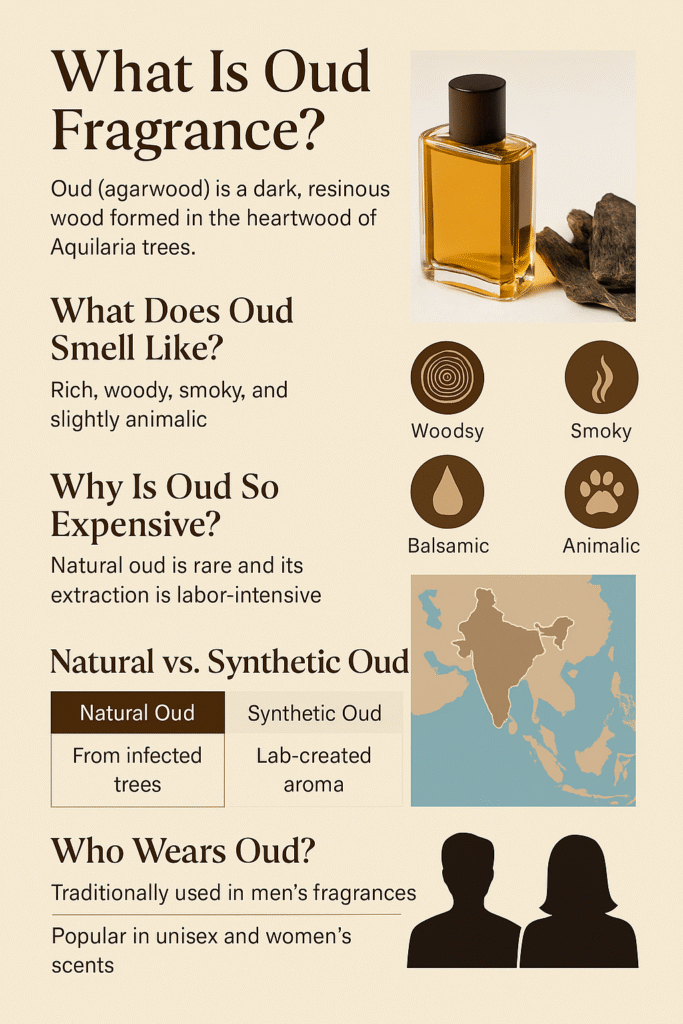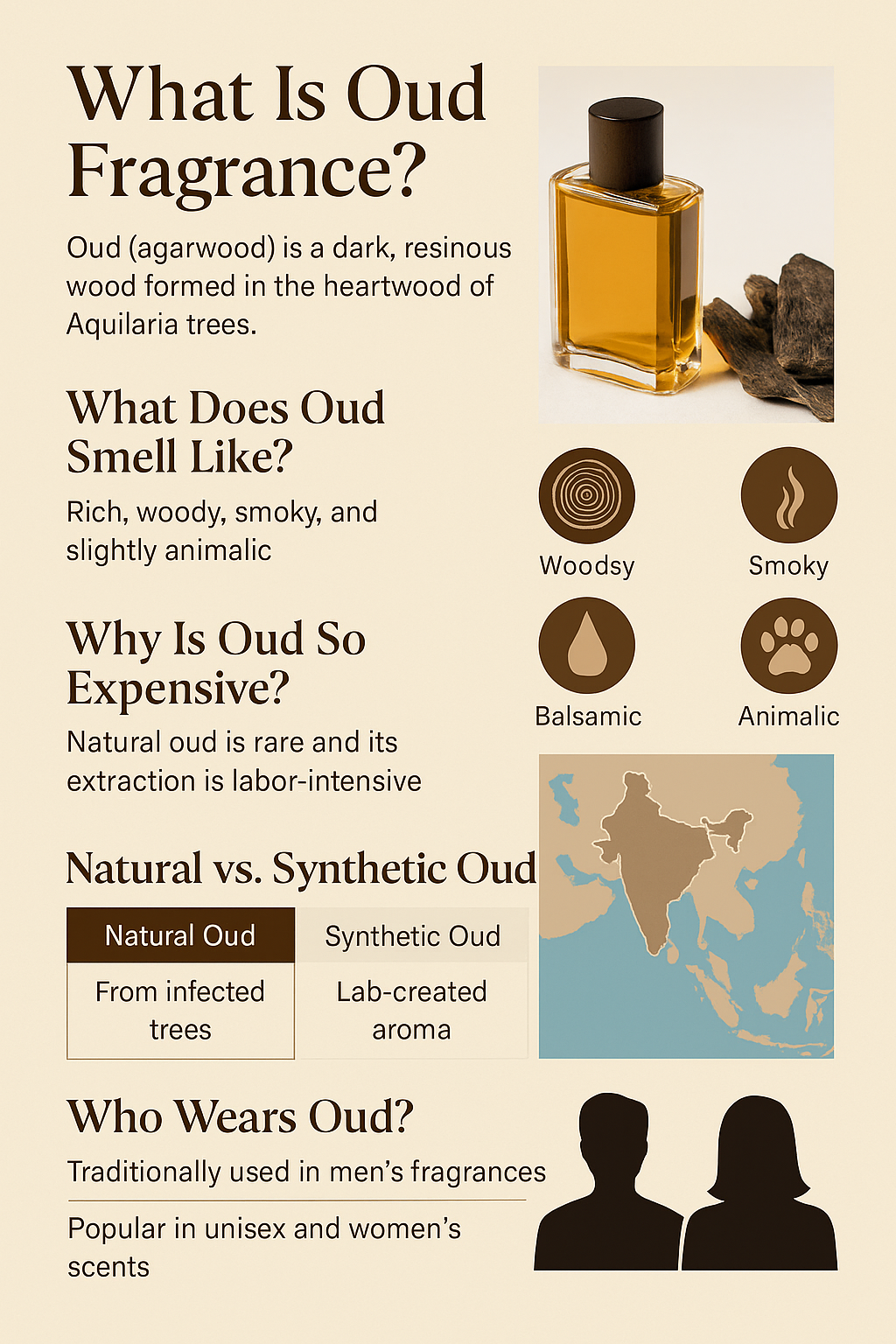🌿 What Is Oud Fragrance? Origins, Scent Profile & Why It’s So Expensive
🧭 Introduction: Oud — The Liquid Gold of Perfumery
If you’ve ever browsed high-end perfumes or niche fragrances, chances are you’ve come across the word “oud.” Revered as one of the most luxurious and mysterious scent ingredients in the world, oud fragrance is often called the “liquid gold” of the perfume world. But what exactly is it? Why does it command such high prices? And what does it smell like?
Let’s dive deep into the world of oud.
🌳 What Is Oud?
Oud (also known as agarwood or aloeswood) is a dark, resinous wood formed when the Aquilaria tree becomes infected by a specific type of mold (Phialophora parasitica). In defense, the tree produces a rich resin to protect itself — this resin-saturated wood is what we know as oud.
🗺️ Oud is primarily produced in:
- India
- Laos
- Cambodia
- Malaysia
- Vietnam
- Middle Eastern countries (as a cultural favorite)
Oud has been prized for centuries in Middle Eastern, Indian, Japanese, and Chinese cultures — used in incense, traditional ceremonies, and later, luxury perfumery.
👃 What Does Oud Smell Like?
Oud’s aroma is complex, intense, and deeply captivating — a bold statement in any perfume composition.
Key scent notes:
- Smoky
- Woody
- Animalic (leather-like)
- Earthy
- Sweet balsamic undertones
No two oud oils smell exactly the same. Depending on the tree species, age, region, and extraction method, oud can range from medicinal and dry to sweet and smooth. The result is a multi-dimensional scent that lingers on the skin for hours.
💰 Why Is Oud So Expensive?
Oud is one of the most expensive raw materials used in perfumery — sometimes costing more than gold by weight. Here’s why:
- Rarity – Only about 2% of Aquilaria trees naturally produce oud resin.
- Time – It can take years for the infected wood to develop.
- Manual Harvesting – Extraction is labor-intensive and must be done with precision.
- Conservation – Overharvesting has led to restrictions. Aquilaria trees are now protected under CITES (Convention on International Trade in Endangered Species).
As a result, natural oud oil is often reserved for ultra-premium fragrances, making it a status symbol in both Eastern and Western perfume markets.
🧪 Natural vs Synthetic Oud: What’s the Difference?
| Attribute | Natural Oud | Synthetic Oud |
|---|---|---|
| Source | Resin from Aquilaria trees | Lab-created aroma molecules |
| Price | Extremely high | Affordable |
| Scent | Rich, complex, multi-faceted | Clean, linear, replicable |
| Availability | Rare, limited harvest | Mass-producible |
| Sustainability | Overharvesting risk | Eco-friendlier alternative |
Synthetic oud, while not as nuanced, allows perfumers to replicate the oud experience without the environmental and ethical costs — and at a much more accessible price point.
👫 Who Wears Oud? Is It for Men or Women?
Traditionally, oud has been associated with Middle Eastern men’s perfumery, thanks to its strong, bold, and mystical character. But in modern fragrance design, oud is widely used in gender-neutral and women’s scents too.
Popular pairings:
- Rose + Oud – sensual and romantic
- Oud + Vanilla – creamy and addictive
- Leather + Oud – dark and powerful
Whether you’re into niche blends or mainstream luxury houses, oud is now a unisex signature for depth and elegance.
🧴 Top Oud Fragrances to Explore
💎 High-End Luxury:
- Tom Ford Oud Wood – smooth, Westernized oud with spice and amber
- Amouage Interlude Man – rich, incense-laden oud powerhouse
🛍️ Designer Picks:
- Dior Oud Ispahan – floral-oud masterpiece with rose
- Versace Oud Noir – bold and woody with an oriental twist
💰 Affordable Options:
- Al Haramain Amber Oud – strong projection, Eastern style
- Armaf Club de Nuit Intense Oud – budget-friendly beast-mode oud
✅ Should You Try Oud?
Absolutely — if you’re ready for something bold, mysterious, and unforgettable.
For oud beginners, we recommend:
- Start with blended fragrances where oud is one of the supporting notes.
- Try samples first — oud is powerful and may not suit everyone’s taste.
- Layer it sparingly to appreciate its full dry-down evolution.
Oud isn’t just a scent — it’s an experience, a heritage, and a luxury. Whether you’re drawn to its ancient roots or modern prestige, oud invites you into a world of olfactory richness few other ingredients can match.
✨ Final Words
Oud fragrance represents the perfect union of nature, culture, and art. While it may not be for everyone, its richness and depth have earned it a loyal following around the globe.
Next time you see “Oud” on a fragrance label, you’ll know: it’s not just another note. It’s a legend.

